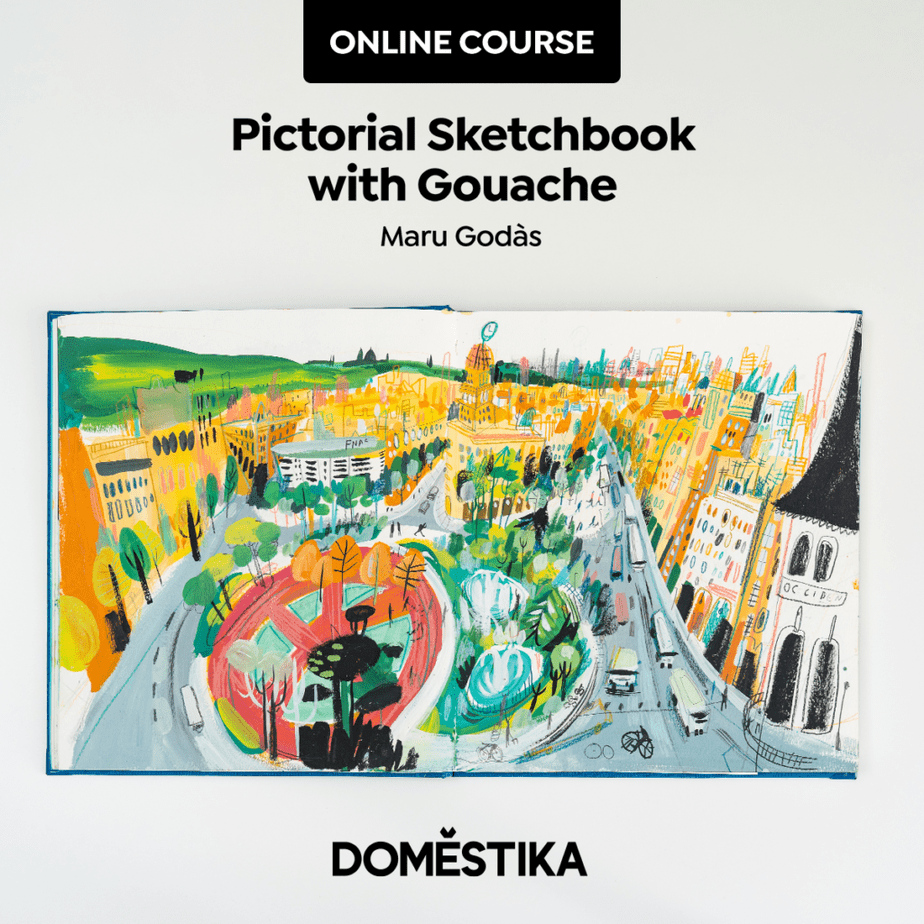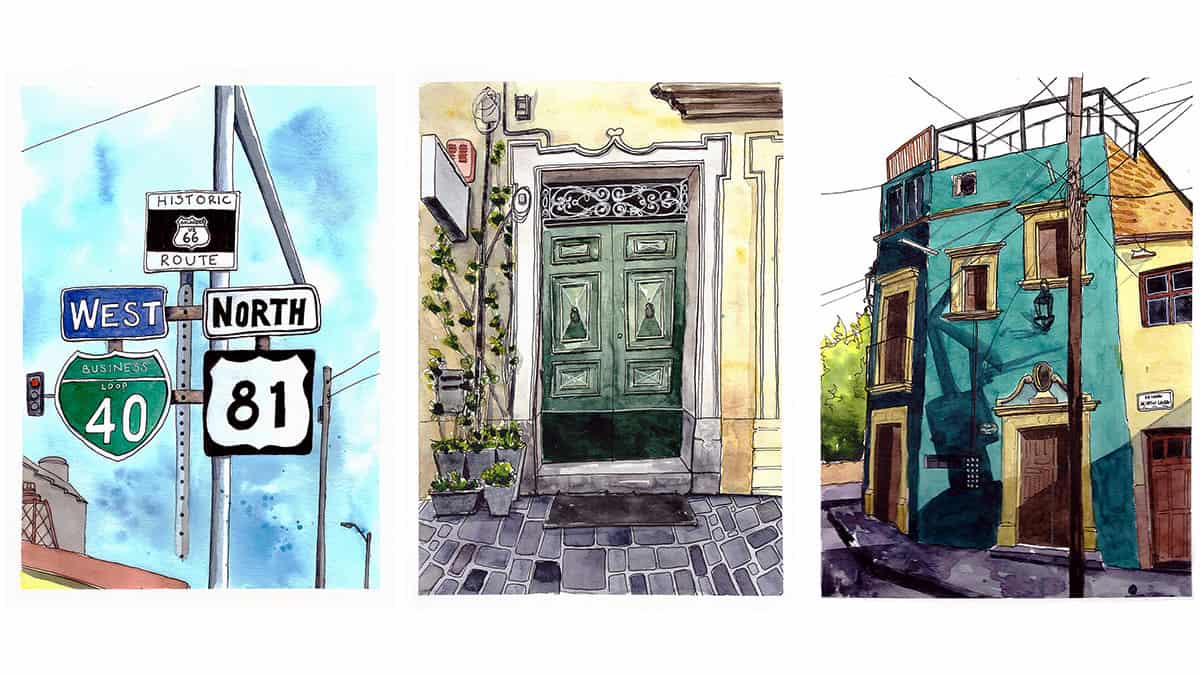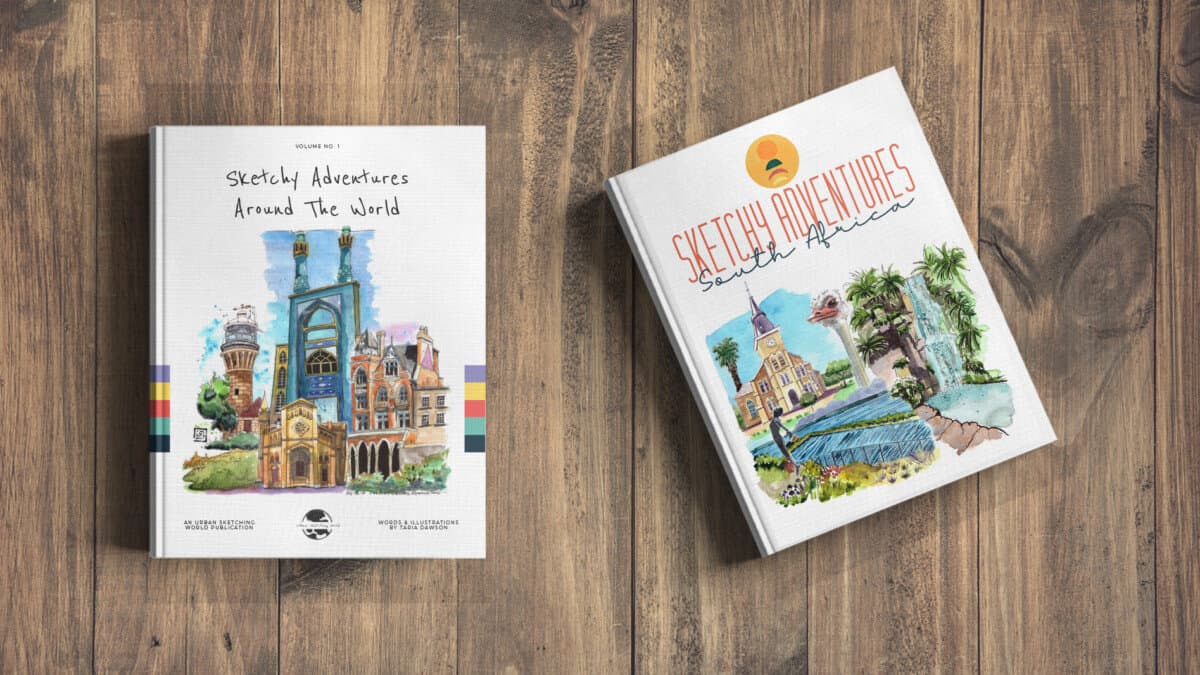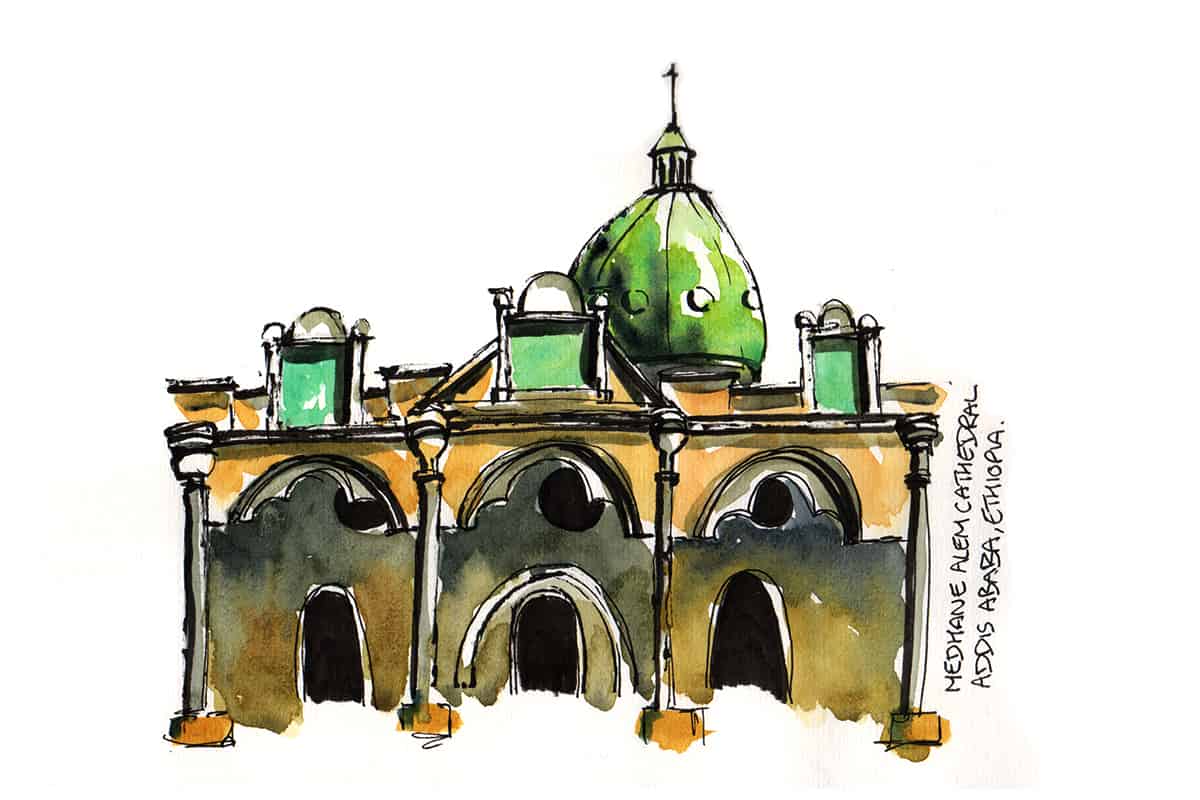When I started getting interested in urban sketching one of the things I noticed is that sketching styles varied so greatly. I was in awe of the way a similar object or scene could be interpreted so differently by different sketchers. Looking at the world through the lens of urban sketchers fascinated me.
As you are learning to develop your own urban sketching style I think its really useful to look at and understand styles of prominent urban sketchers. Experiment with different elements from other sketchers and use them as building blocks in order to learn or even develop your own unique style.
In this post, we will look at different urban sketching styles unique to each artist and analyse what they are doing to see what we can try out in our own next sketch.
This is a super interesting exercise to break out of working in the same old way and see if you can bring something fresh to your next sketch.
Mediums for Urban Sketching
Urban sketchers use a wide variety of different mediums, the most important thing for urban sketching is that the medium is portable and low maintenance. Plein-air painters may use oil or acrylic paint on location but that’s a different kettle of fish to urban sketching.
Urban sketching is a faster more organic process, sometimes you may just whip out a pen at a moment’s notice and do a sketch on a napkin in the cafe because something caught your eye and you just had to sketch it.
Urban sketchers will roam around, sketching the world as they go. Plein-air painters have a lot of equipment and an easel, they will most likely wander around looking for just the right scene and composition, set up and then stay put for 3 or more hours and develop a very involved piece of art. Perhaps I’m simplifying things but in my mind, this is the difference between them.
Firstly let’s discuss different mediums urban sketchers use, as this has a bearing on style and then we will get into specific sketchers and look at their personal style.
The use of different mediums can inform a sketcher’s style, although does not define it.
Just like a musician may favour playing the piano, it doesn’t necessarily mean they are a pianist. They will play the piano in a way personal to them, no matter the genre of music. And they may occasionally pick up the guitar instead but it’s still that musician playing an instrument in their own style.
Pen & Ink
Paul Heaston always springs to my mind when I think of urban sketching using simply a pen and a sketchbook. Tommy Kane also uses just a pen for a lot of his sketches, sometimes different colours of pen on the same page.
Both Paul Heaston and Tommy Kane are well known for their expressive use of hatching and cross-hatching too.
Dwayne Bell, who I mentioned in my post on reportage illustration here, uses only a Lamy Safari fountain pen to record commuters on his bus route to work.
There is a sense of freedom that comes with having minimal sketching tools to carry and work with.
Black Marker
James Hobbs was one of the first urban sketchers I came across. His urban sketches of London in a thick black marker captivated me. They just seem so raw and fresh. This proves you really don’t need much to get out there and sketch. One black permanent marker pen (such as an Edding 3000 like this one on Amazon) and one sketchbook. Job done!
Markers
The first urban sketcher I think of when I think of sketching with markers is Don Colley. He does amazing things with Faber Castell Pitt pens and officially represents them, doing demonstrations at exhibitions and such.
I also see an increasing amount of people using markers for urban sketching-style illustrations on Instagram. One of my favourite urban sketchers using markers is Albert Kiefer (@housesketcher). I have followed him for many years and watched his profile grow. He now has his own Domestika course teaching what he knows which I highly recommend! You can check it out here.
More recently I discovered the artist @lemony987 who also uses markers beautifully to capture the urban landscape.
I say “urban sketching style” illustrations because I’m not sure which of these sketches are done on location. I think one of the reasons we don’t see too many on-locations sketchers with markers is that they are not as portable as watercolours. You would need to carry around a large bag as you need one marker per colour. Or be content working in a limited palette and carry just a selection.
I love the graphic quality you can get with markers and it’s a medium I’m keen to try to work with more often (probably at home though).
Watercolour Markers
I have had a go with watercolour markers a few times, here is a sketch from Iran below (I did this from a photo at home though). Again, markers aren’t the most portable of mediums and certainly not very appropriate to take backpacking! I took to carrying 2 markers around with me when I first visited South Africa, a light grey and a dark grey, but eventually, I stopped taking them with me as I didn’t use them enough.
It seems watercolour markers just aren’t a popular choice for urban sketchers, I think most are of the opinion that watercolour paints are better suited to this method of creating art (i.e. sketching on location). However, Liz Steel has started to explore them more in her work recently. It’s worth checking out her blog for some of her experiments with different mediums.
Watercolour Paint
There are far too many sketchers to mention in this category as it’s the “weapon of choice” for many an urban sketcher. In my post, Urban Sketchers to Follow, I list my favourite urban sketchers and all of them use watercolour (an unconscious pattern – it just worked out that way). Alicia Aradilla works beautifully in watercolour, as does ‘Captain Tom’.
Ian Fennelly and Felix Scheinburger have extremely distinct watercolour styles that I love too. It’s amazing how every single artist can use the exact same tools and produce artwork so unique. It’s magical. I suppose you could say the same about musicians and 12 notes.
Gouache
James Gurney is an absolute master at capturing scenes in his small sketchbook with a limited palette of gouache. James leans more towards the plein-air painter side of things as he will set up his small easel and get his paints out. However, his kit looks small and portable and if his Youtube channel is anything to back he will paint anything and everything, the more mundane the better! Do check out his videos if you haven’t already, I absolutely love watching them.
On the completely other end of the scale, there’s Maru Godas who unashamedly teaches workshops with titles such as “Gouache Like a Child”. Many of us have lost the connection with our inner child, creating art with abandon and without judgement as we did when we were 7 years old. Well, Maru is connected. Her work is sublimely playful and expressive. When I look at her work I can sense her inner joy and I just feel the word FREEDOM. It’s magical. Oh and even better, she has a Domestika course where she shares what she knows about urban sketching in gouache! I urge you to check it out immediately.

Colour Pencil
Lynne Chapman was another of the very first urban sketchers I discovered. Based out of Sheffield, UK, Lynne’s predominant profession is as a children’s book illustrator. However, she is also an educator and urban sketcher.
I love her drawings of sleepy commuters on her frequent train rides. She captures them so beautifully, usually with coloured pencils, sometimes even with one of those coloured pencils that has multiple colours in one lead!
You know there’s talent there when she can sketch wonderfully using one of those! Check out Lynne’s sketches here and click on ‘Secret Portraits’.
Lynne also shares her thoughts on sketching in public in her blog post here.
If you would like more information on the art supplies I use and recommend, head over to my Recommended Stuff page. In addition to art supplies I share my favourite books and courses too!
Digital/iPad
I think one of the most well-known urban sketchers for using an iPad to sketch is Rob Sketcherman. I occasionally see other urban sketchers start to experiment with using an iPad but Rob is certainly the authority on this medium, at least in the urban sketching community!
I used to have an iPad Pro and Apple Pencil at one time. I didn’t do much urban sketching on it but did try my hand at some digital illustration using the app Procreate and the results were amazing once I got the hang of it. In fact, I feel that I learned a lot about how to shade and use light. The digital process made me more experimental as I knew I could easily “undo” or delete something.
I sold the iPad when I went left my home to travel indefinitely. It wasn’t an item I wanted to carry around with me. Also, I really did just miss the feel of drawing in a traditional way. There’s something so beautiful about just using some pen and paper!
Using different mediums is a useful way to unconsciously draw or paint in a different way, it almost forces you to experiment with your sketching style.
Suggested Exercise
Sketch the same scene/building/object 3 times in 3 different mediums of your choice. Pay attention to how the medium affects your sketch. See if the medium you use changes your overall style. Which sketch do you like the best?
Let’s look a little more closely at the specific styles of some well-known urban sketchers.
Want to learn travel sketching in ink & watercolour?
Check out my course, Sketch Your Adventures and for a limited time get 50% OFF!!!

What Does ‘Style’ Mean?
Despite our discussion above, style is not defined just by using different mediums. Sketchers can interpret what they see and relate it on their page using one of the styles or techniques below, which then may become a signature of sorts, something that artist becomes very well-known for doing.
- Realistic
- Expressive
- Graphic
- Loose
- Exaggerated proportions / perspective
- Selective colour
These are examples and certainly not a definitive list!
These are just a handful of styles and I’m putting these labels on sketchers’ work myself, so this is my opinion not what the sketcher themselves label their work as.
It helps to label them as something so we can discuss them a bit further. You may not agree with my classifications and that’s ok! It’s just a jumping-off point.
Realistic / Highly Detailed
Paul Heaston draws an overwhelming amount of detail in his sketches. He also plays with perspective. He is well known for his fish eye illustrations, trying to capture as much of the scene around him as possible. Check out his Youtube channel for some fantastic timelapse videos of Paul sketching in his iconic fisheye perspective to fit the whole room in one double-page spread. You can watch an example in the video below:
Andrea Joseph is well known for her mind-boggling sketches in ballpoint pen. This is how I discovered her work, I think it went viral on Pinterest a number of years ago. I think Andrea has switched gears a bit these days to a looser more expressive style but when I became aware of her it was because of her staggering abilities to render items so realistically in ballpoint pen. In the video below she shows her approach to sketching realistic objects using cross-hatching.
Expressionism
When I think of sketchers in this style I always think of Felix Scheinburger and Inma Serrano. Interestingly, they are both university-level lecturers in Art & Design. I only just thought about that. Both use vibrant, energetic colours with wild loose mark-making.
Felix Scheinburger is actually I really good example of an artist with an extremely distinctive style who is not beholden to one type of media, he uses all sorts of things. The elements that make his style distinctive are nothing to do with the way he uses a particular medium. I find this very interesting.
Below is a video of Danny Gregory talking through and showing pages from some of Felix’s books. If you don’t know of Felix, this video is quite a nice overview of some of his work, including covert sketches of nightclubs in Berlin!
Whenever I look at Inma Serrano’s work, and more specifically her sketchbooks, all I can think is FREEDOM…literally the word bounces around my brain in all caps. As part of the Watercolor Rules course by Sketchbook Skool, Inma takes us through some of her sketchbooks. Her drawings echo the free expressive lines of a child, as she uses crazy bright yellows and pinks to highlight certain areas. Her use of bold raw colours along with her quick lines and disregard for any sort of realism or detail just blows my mind because you still get such a sense of the scene, where she was, and what she was experiencing.
I just feel this sensation of wanting to keep going back to look at her sketches more, figure them out, absorb and feel them. Inma really inspires me to just sketch whenever and whatever and not to agonise over the marks I make or whether I’m capturing the details correctly and to use whatever colours I FEEL like the scene needs.
Suggested Exercise:
Sketch with a thick black pen and choose your favourite bold colours to paint accents throughout the scene.
If you try this out, tag me on Instagram (@urbansketchingworld) so I can see!
Check out my ebooks with hundreds of ink & watercolour travel sketches from all over the world. Get some inspiration for your next trip…

Graphic
I’m not sure if I am using the name of this style correctly but I think you know what I mean, some sketchers (and their sketchbooks) are just so wonderfully bold and simple yet very neat and precise. The urban sketcher that springs to mind is Danny Hawk.
Danny has a very bold, graphic style. Some elements are simplified and it lends a whimsical feel to his illustrations. Danny has key elements to his style. He usually paints his sky in a specific shape and he outlines the contours of people or cars for example and leaves these as negative space. I think it’s super interesting. When I see a sketch by Danny, I automatically know it’s by him. A mark of having a definitive style.
I also think of Lapin as he is another sketcher who seems very neat and precise in illustrations, not to the point of being realistic but his lines are clean and he doesn’t splash paint around and let watercolour make its own art on the page. I suppose he ‘tints his sketches’ as Marc Taro Holmes would say.
Loose
Liz Steel has a beautiful loose style, she can really sketch quickly in watercolour or with her fountain pen. She captures the energy of a scene and expresses light so swiftly. Liz tends to sketch in watercolour and she’s especially deft at leaving negative space for light. She then goes in with some line work, usually with a Lamy Joy fountain pen to define certain areas.
I remember Liz saying in a podcast interview that she’s not trying to make a masterpiece, she just wants to capture the essence in front of her. Incidentally, if you want a fresh batch of art-related podcast recommendations, check out my post here.
Some of my favourite online classes
- Urban Sketching: Create Expressive Cityscapes – Eleanor Doughty
- Urban Sketching: Express Your World in a New Perspective – Lapin
- Urban Sketching: Capture You City in Motion – Inma Serrano
- High Street Sketching Course – Ian Fennelly
Exaggerated Proportions & Perspective
Again, I’m thinking of Lapin here and the perspective he draws cars in or how he will just bend the tops of towers to fit buildings within his sketchbook page or his famous ‘big head’ sketches of people in which he draws the head far larger than the body.
Selective Colour
I am fascinated with Simone Ridyard’s work.
I love how she captures a scene in her fine pen lines and then just splashes a hint of a bright blue or red in a specific area, leaving the rest unpainted. It’s such a striking style and something I certainly want to experiment with this technique in my own sketches. The problem is I always get carried away and end up painting everything!
Conclusion
By analysing other artists’ styles you can understand what they are doing and how they achieve the overall effect and feelings they evoke from their sketches.
Try to emulate elements of the styles above. This is a learning exercise. Do not copy. Just try to understand the way Inma Serrano uses colour, or the way Lapin manipulates perspective, or try a very detailed realistic sketch like Andrea Joseph.
See what’s comfortable to you, what’s fun and what makes you want to draw and experiment further. Play with different mediums, whether it’s a ballpoint pen, a thick black marker or delicate watercolour with no lines at all.
It’s not until you experiment and try lots of different things that you may hit upon something you particularly love, or a style entirely unique to you. Never stop playing!
And if you want to play in a more structured way, come join us on Patreon. I release weekly demonstrations around a theme for each month. We explore different techniques, styles, subject matters and mediums. You can find out more here.

